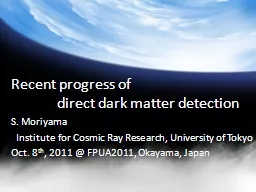PPT-Recent progress of
Author : debby-jeon | Published Date : 2016-08-16
direct dark matter detection S Moriyama Institute for Cosmic Ray Research University of Tokyo Oct 8 th 2011 FPUA2011 Okayama Japan Principle of direct detection
Presentation Embed Code
Download Presentation
Download Presentation The PPT/PDF document "Recent progress of" is the property of its rightful owner. Permission is granted to download and print the materials on this website for personal, non-commercial use only, and to display it on your personal computer provided you do not modify the materials and that you retain all copyright notices contained in the materials. By downloading content from our website, you accept the terms of this agreement.
Recent progress of: Transcript
Download Rules Of Document
"Recent progress of"The content belongs to its owner. You may download and print it for personal use, without modification, and keep all copyright notices. By downloading, you agree to these terms.
Related Documents














